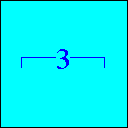 A tuplet is a group of notes evenly condensed or
expanded over a specific duration of time. For instance: A group of three eighth notes may
be played within the space of one quarter note. The tuplet sign is normally placed above
or below the group of notes outside the musical staff.
A tuplet is a group of notes evenly condensed or
expanded over a specific duration of time. For instance: A group of three eighth notes may
be played within the space of one quarter note. The tuplet sign is normally placed above
or below the group of notes outside the musical staff.
![]()
A tuplet can be any number of notes of any duration, grouped by a sign, to indicate that it should be played within a measured amount of time as it would normally be indicated by another group of note values. The following are tuplet note groupings with their technical terms.
Term Number of Notes

| duplet | two |
| triplet | three |
| quadruplet | four |
| quintuplet | five |
| sextuplet | six |
| septuplet | seven |
| octuplet | eight |
| nontuplet | nine |
 A tuplet may be represented with a number in
three ways. A number within a bracket helps to identify tuplet groupings that are not
beamed. Such notes are anything greater or equal in value than a quarter note.
A tuplet may be represented with a number in
three ways. A number within a bracket helps to identify tuplet groupings that are not
beamed. Such notes are anything greater or equal in value than a quarter note.
 A slurred tuplet identifies a group of notes to be
played legato. It is much more simple to read than having bracket
tuplets combined with slurs.
A slurred tuplet identifies a group of notes to be
played legato. It is much more simple to read than having bracket
tuplets combined with slurs.
 Sometimes a tuplet grouping may be represented by
a number only. This can be used with beamed notes only. Beamed notes are anything equal or
smaller in value than an eighth note.
Sometimes a tuplet grouping may be represented by
a number only. This can be used with beamed notes only. Beamed notes are anything equal or
smaller in value than an eighth note.
The ratio of the tuplet groupings depend very much on the time signature. The first number of the ratio indicates how many notes there are in the tuplet. The second number indicates how many note values that tuplet will occupy. Therefore, three notes in the space of two means that a triplet grouped with notes of a particular value takes up the space of two notes of the same value.
 In simple time, the
second number of the ratio will either be a two, a four or an eight. The first number of
the ratio will always be bigger than the second number providing it remains less than the
second number's following value. (Select Simple Time Tuplets.)
In simple time, the
second number of the ratio will either be a two, a four or an eight. The first number of
the ratio will always be bigger than the second number providing it remains less than the
second number's following value. (Select Simple Time Tuplets.)
 In compound time, the
second number of the ratio will either be a three, a six or a nine. The first number of
the ratio follows the same rules as in simple time. The only
exception is the 2:3 ratio where two notes fall within the space of three. (Select Compound Time Tuplets.)
In compound time, the
second number of the ratio will either be a three, a six or a nine. The first number of
the ratio follows the same rules as in simple time. The only
exception is the 2:3 ratio where two notes fall within the space of three. (Select Compound Time Tuplets.)
 There are two cases when the ratios should be
considered irregular. One irregularity is when the first number of the ratio is smaller
than the second. The other is when the second number does not equal to any of the standard
numerical values in simple or compound time
(as mentioned above). It is better to put the entire ratio in the tuplet figure to
facilitate reading.
There are two cases when the ratios should be
considered irregular. One irregularity is when the first number of the ratio is smaller
than the second. The other is when the second number does not equal to any of the standard
numerical values in simple or compound time
(as mentioned above). It is better to put the entire ratio in the tuplet figure to
facilitate reading.